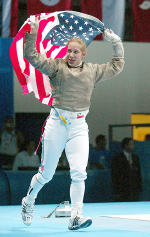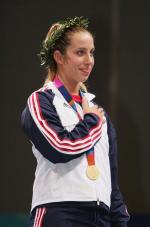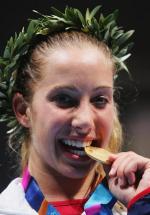Aug. 18, 2004
By Pete LaFleur
ATHENS, Greece – You can’t always get what you want. Sabre fencer Mariel Zagunis found that out the hard way. Zagunis, currently ranked fourth in the world, had delayed her enrollment at Notre Dame for a year in order to chase her Olympic dream – but she missed out on capturing one of two spots on the initial U.S. roster, by the narrowest of margins (a single touch). The cutoff date for Olympic qualifying was April 1 and Zagunis was on the outside looking in … until a fateful day in mid-June gave her another chance. With Freshman Orientation week just around the corner for the incoming Notre Dame student-athletes, Zagunis pounced on the opportunity that was provided by the withdrawal of a Nigerian fencer and she rode the underdog role all the way to the gold-medal stand (the first American fencer to do so in 100 years).
In the 21 months since signing with Notre Dame in November of 2002, Zagunis has continued to add to her impressive resume (per NCAA regulations, Notre Dame was not permitted to publicize her post-signing accomplishments … until that legislation ended on Aug. 1).
The Beaverton, Ore., native is the only fencer ever to win three gold medals at one World Championships. She was a member of the first U.S. team ever to capture the gold medal in World Championship competition. She won three consecutive Junior World Cup trophies. And she compiled an unprecedented eight medals at Cadet and Junior level World Championship events.
Many sports have aspects that are unique to its subculture and fencing certainly is one of them. The compilation system for Olympic qualifying points essentially left Zagunis and fellow American Emily Jacobson battling for the final spot on the U.S. Olympic roster. Ironically, it all came down to a bout at a late-March tournament in Italy, versus Sada Jacobson (Emily´s older sister and the world´s No. 1-ranked women´s sabre fencer).
Sada Jacobson claimed the narrow 15-14 win that day and the resulting world rankings left her sister in 10th and Zagunis in 11th.
“If I had beat her, then I would have made it,” Zagunis told the Associated Press. One single touch apparently was going to keep her from her Olympic dream. (Note: because sabre is a “young” weapon, the team´s entry was limited to a pair of fencers, as opposed to the three in all three men´s weapons and women´s foil and epee).
The U.S. Fencing Association knew that there was an outside chance Zagunis still could be added to the Olympic field, if a fencer from another nation was forced to withdraw. So when it came time for the official U.S. team photos, they took two snapshots: one with Zagunis and one without her. Weeks later, they ditched the second photo and kept the one with Zagunis´ smiling face.
The opening came when the Nigerian federation declined to have its fencer compete in the Olympics. That fencer, Jacqueline Esimaje, was the only individual from the African region listed in the world women’s sabre rankings and thus the spot went to the highest ranked fencer not already in the Olympic field. It went to Zagunis, who by that point had risen to 6th in the world rankings.

Mariel Zagunis jubilates after she took the gold medal. (AP Photo/Michael Sohn)
|
“Before we heard the news, I had kept training and kept my fingers crossed and just waited and hoped for the best,” said Zagunis, who finally heard the good news on June 6, in a jammed bus at an airport terminal. The bearer of the good news was former Notre Dame assistant coach Ed Korfanty, who coaches Zagunis (and several other current ND fencers) at the Northwest Fencing Alliance elite sabre academy in the Portland area (he also coaches the U.S. women’s sabre squad).
Just a handful of U.S. fencers ever have stood on the Olympic medal stands and the last to do so was men’s sabre bronze medalist Peter Westbrook at the 1984 games in Los Angeles. The U.S.S.R.-led boycott of those Games cleared the field a bit for Westbrook, as it did when former Notre Dame fencer Bjorn Vaggo won the epee silver at the 1984 Los Angeles Games (fencing for his native Sweden). Zagunis won her medal with every top challenger from throughout the world on hand to contend for the gold.
The only previous U.S. fencers to win the gold came in the 1904 “single sticks” competition, an event that was not attended by many top Europeans due to the difficulty at that time in reaching middle America (St. Louis).
The only previous Olympic gold medalists with Notre Dame ties are basketball players Vince Boryla (1964, in Tokyo) and Adrian Dantley (1976, in Montreal) – but Boryla had transferred to the University of Denver prior to his Olympic participation.
Seven other former Notre Dame student-athletes have combined to win nine Olympic silver/bronze medals, with the most coming in track and field: August “Gus” Desch (bronze in the 400 meters; 1920 in Antwerp); Tom Lieb (bronze in discus; 1924 in Paris); Canadian three-time medalist Alex Wilson (bronze in the 1,600 meters at Amsterdam in ’28; then silver in the 800 and bronze in the 400 at Los Angeles in ’32); Jim Delaney (silver in shot put; 1948 in London); and Rick Wohlhuter (bronze in 800 meters; ’76 in Montreal). Others include Vaggo’s silver in the ’84 epee and women’s soccer defender Kate Sobrero (silver at Sydney in 2000).
Notre Dame’s all-time Olympic “medal count” now includes three golds, four silvers and five bronzes.
Desch held the distinction of being the only “active” Notre Dame student-athlete ever to compete in the Olympics, with swimmer Christal Bouvron joining that short list earlier this week when she competed for her native Singapore in the 200-meter butterfly.
Lieb also was a star lineman during the glory days of the Knute Rockne-coached Notre Dame football teams while Wilson later returned to his alma mater (Notre Dame) as a highly-regarded track and field coach. Wohlhuter also received the Sullivan Award as the nation’s top amateur athlete while Sobrero and former Notre Dame teammates Shannon Boxx (U.S.) and Monica Gonzalez (Mexico) currently are in the running to help their teams claim a medal finish in women’s soccer.
The impending addition of Zagunis will give Notre Dame a 2004-05 women’s fencing squad that (on paper) could be the best in NCAA history. Valerie Providenza, a teammate of Zagunis at the NFA, won the NCAA sabre title as a freshman last spring while senior foilist Alicja Kryczalo is the three-time defending NCAA champion in that weapon (just the second women’s fencer ever to win three-plus NCAA titles). Kryczalo’s classmate Andrea Ament easily could have a couple NCAA titles to her credit if she fenced a few years earlier or later, as she twice has lost to her ND teammate in the NCAA final bout (’02 and ’04) while finishing third in ’03. In epee, fifth-year veteran Kerry Walton is a former NCAA champ in her own right (’02, also ’04 runner-up and 5th in ’03) while sophomore epeeist Amy Orlando was an All-America performer at the ’04 NCAAs (placing 10th).
Zagunis won the gold medal with American flags waving in the sold-out stands. The future Notre Dame star commanded the bout against Xue Tan of China from the beginning, running an 8-2 streak by the first break. Zagunis fenced with tenacity and imagination, scoring for instance with point-in-line at 5-2. After the break Tan rallied, changing her game and taking the score back up to 10-6 to the chants of the large contingent from China. But Zagunis was not to be denied and gritted out the next few touches to finally win 15-9.

Mariel Zagunis poses with her gold medal. (Photo by Adam Pretty/Getty Images).
|
She was immediately tossed in the air by her teammates, who rushed the piste.
Moments before the gold-medal bout, Sada Jacobson (Dunwoody, Ga.) claimed the bronze medal – with Zagunis technically becoming the first U.S. women’s fencer ever to clinch an Olympic medal (the color, gold or silver, just had yet to be determined). For the first time since 1904, the Star Spangled Banner was played at an Olympic fencing medal ceremony (recognizing the gold-medal winner).
Zagunis’ win avenged Jacobson’s earlier 12-15 loss to Tan. For her part, Jacobson defeated Leonore Perrus of France in the quarterfinals, who had earlier knocked younger sister Emily Jacobson out of the event in the round of 16.
Jacobson commandingly defeated Catalina Gheorghitoaia of Romania in the bronze-medal bout. She led the bout from the beginning and gained momentum throughout, leading 8-5 at the break and 15-7 in the end.
Zagunis defeated Elena Jemayeva of Azerbaijan 15-11 to advance to the semifinals.
With so many highly-skilled fencers competing, factors beyond skill and preparation come into play.
“At this stage of the game, it’s completely mental,” Zagunis said.
Tan beat Jacobson 15-12 in one semifinal to reach the gold-medal match.
In the quarterfinals, Jacobson beat Leonore Perrus of France 15-11. Perrus had knocked out Sada’s sister, Emily, 15-13 in the round of 16, preventing the sisters from playing each other.
“I honestly, really expected Emily to make the (final) eight. I had really thought she was going to do it. I had really prepared myself to fence her,” Sada Jacobson said. “I’m sorry she didn’t win her bout, but when it comes down to it, it was only going to be one of us, anyway.”
Sada Jacobson is ranked No. 1 in the world and Zagunis is ranked fourth. Tan is No. 5.
Women’s sabre is the newest of fencing’s six disciplines and is making its first appearance in the Olympics. The first world championship in women’s sabre was held in 1999.
Sabre is the fastest of fencing’s three weapons. The target area is the entire body above the bend in the hips, including the head. Unlike in foil and epee, sabre fencers can score with either the tip or the edge of the blade.

Mariel Zagunis poses with her gold medal at Helliniko Olympic Complex Fencing Hall. (Photo by Chris McGrath/Getty Images).
|
The semifinals saw Zagunis defeat Catalina Gheorghitoaia of Romania, 15-10. Zagunis won six straight points to claim a 6-1 lead and led 8-2 at the break before weathering a minor comeback by Gheorghitoaia, with Zagunis using her patience and strength to close out the win. In the other semifinal, U.S. standout Sada Jacobson could not overcome Tan’s athletic distance in a 15-12 decision.
Zagunis entered the Olympics with a No. 4 world ranking, behind Jacobson, Russia’s Elena Netchaeva and France’s Anne-Lise Tonya (Gheorghitoaia is 11th in the world rankings and Tan is 5th).
See the following link for a feature story on Zagunis: http://www.collegesports.com/sports/c-fenc/stories/061504aaa.html
With Athens Olympic Organizing Committee Chairwoman Gianna Angelopoulos-Daskalaki looking on, Jacobson defeated Leonore Perrus of France 15-11 in the sabre quarterfinals Tuesday morning at the Helliniko Olympic Complex. Zagunis then won her quarterfinal by the same score (15-11) over Elena Jemayeva of Azerbaijan (the world’s #14-ranked women’s sabre fencer).
Zagunis made it to the semifinals by breaking an 11-11 tie with a 4-0 run against Jemayeva. Along the way, her Azerbaijani opponent drew a yellow card from Korean referee Chung Gon Kim. The quickly-moving bout lasted just 55 seconds, with Zagunis claiming an early 2-0 lead before ties at 3, 4 and 5. Zagunis led 8-5 at the midpoint but Jemayeva stormed back to forge a 9-9 tie (then 11-11 as well).
In the round of 16, Zagunis knocked off Japan’s Madoka Hisagae (#31 in the world) following a longer bout (2:39) that saw the score tied 1o times from 4-4 to 13-13. Zagunis had led 3-0 before losing the next four touches. She then led 8-7 at the midpoint and won the final two points for the 15-13 victory.
France’s Perrus had eliminated Jacobson’s sister Emily (15-13 in the round of 16), eliminating the possibility of the sisters fencing each other (Emily Jacobson is 10th in the world rankings).
Mariel Zagunis Pre-Olympics Biography – considered one of the top sabre fencers in the world (for all age groups), Zagunis signed with Notre Dame in November of 2002 but delayed her admission in order to make a run at qualifying for the Olympic Games … the various formulas for determining entrants originally called for just two women’s sabre fencers from U.S. and Zagunis heartbreakingly missed out on qualifying by a single touch (sisters Sada and Emily Jacobson, from Dunwoody, Ga., earned those berths) … Nigeria later decided not to fill its spot in the field and that opened a position for Zagunis, whose Olympic dream will be fulfilled later this month … recently placed 6th at a Senior World Cup event in Orleans, France, while helping U.S. women’s sabre team take 2nd at World Championships … the 19-year-old is a native of Beaverton, Ore., attended Valley Catholic HS and trains at the Oregon Fencing Alliance under U.S. women’s sabre national team coach and former ND assistant coach Ed Korfanty (three rising sophomore sabres on the ND fencing team also are products of OFA, including ’04 NCAA champ Valerie Providenza, plus Angela Vincent and Patrick Ghattas) … as just a 15-year-old, she won the 2001 World Junior Championship to join foilist Iris Zimmermann as the second U.S. fencer ever to win two World Championship titles (Kazimieras Campe and Ray Sexton are the only other U.S. fencers to claim the elite World Championship titles) … beat teammate Amelia Gaillard in ’01 World Junior Championship round-of-8, then beat the world’s #2-ranked sabre Anna Lise Touya of France in semifinal (15-13) before bearing her teammate Sada Jacobson in the 15-11 final … recently lost to Jacobson in the final bout of the Junior/Under-20 World Championships (15-6), after beating her club teammate Caitlin Thompson (the cadet-level/under-17 world champ) in the round-of-32 (15-8), Leonore Perrus of France in the round-of-8 (15-12) and Sophia Velikaia of Russia in the semifinals (15-9) … ranked 6th in the world (Sada Jacobson is #1 and Emily #8) … named the 2001 female athlete of the year by the U.S. Fencing Association … her many unique accomplishments include becoming: the first fencer to win three World Championship titles in one season (the 2001 under-17 and under-20 individual titles, plus the under-20 team title); the first U.S. fencer to hold four World Championship titles in a span of only nine months (also the 2000 overall team title); the only U.S. fencer to win multiple Junior World Cup trophies (’02-’04), based on point system from several events; the youngest fencer ever to win an FIE World Championship gold medal and youngest ever to win three in one season; the first U.S. fencer ever to finish atop the overall World Cup point standings (’02); and the recordholder for most medals in junior and cadet World Cup Championships (8) … her other top ’01 finishes that helped her earn USFA female athlete of the year included finishing ranked No. 1 in the U.S. under-17, under-20 and senior/overall rankings, winning the Junior Olympic title and the under-16 national title … just two previous U.S. fencers ever had won Junior World Cup titles (sisters Felicia and Iris Zimmerman, in ’95 and ’97 foil) … combined with Sada Jacobson as first U.S. 1-2 finish in the World Cup standings … her cadet world title in ’01 included a thrilling 15-14 win over Leonore Perrus to reach the gold-medal round, beating the Ukraine’s Dariy Nedachdouvska in the final bout (15-10) … played soccer since the age of five, competing on various state-select teams … her brother Marten Zagunis is a top sabre fencer at Penn State … the women’s sabre bouts at the Olympics will be contested on Aug. 17, in a single-elimination format (there is no team competition in women’s sabre at the ’04 Olympics).







